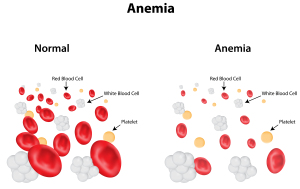Iron deficiency anemia
This is the most common form of anemia due to such diverse causes as a result of chronic blood loss (ulcers, polyps in the colon or colon cancer), heavy periods in women or chronic nose bleeds (epistaxis). In the same vein, with iron deficiency there seems to be a slow down of the metabolic pathway of building up hemoglobin. As a result iron deficiency anemia develops. You can read about it under “anemia due to blood loss” (link under “Related Topics” below).
Sideroblastic anemia
Above all, this type of anemia is an iron utilization anemia, in other words, the bone marrow has difficulties utilizing iron for hemoglobin synthesis. Sideroblastic anemia seems like it is hereditary. It maybe part of a myelodysplastic syndrome, but likewise it can also be due to certain drugs (chloramphenicol, isoniazid, cycloserine etc.) or toxins like alcohol and lead.
Symptoms
The symptoms are the same as for all the anemias.
Diagnostic tests
To clarify, a blood smear shows targeted red blood cells with basophilic stippling (bluish color spots). If myelodysplastic syndrome is present, there are other features associated with this condition. If not, for instance lead levels should be done to rule out lead poisoning.
Treatment
Most noteworthy, a patient with alcohol induced sideroblastic anemia will recover quickly when he/she stops consumption of alcohol. Some of the more rare forms of congenital sideroblastic anemias may respond to pyridoxine 50 mg three times per day.
References
1. Merck Manual (Home edition): Anemia
2. Noble: Textbook of Primary Care Medicine, 3rd ed., Mosby Inc. 2001
3. Goldman: Cecil Medicine, 23rd ed., Saunders 2007: Chapter 162 – APPROACH TO THE ANEMIAS







